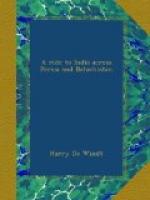It seemed, next morning, as if we had jumped, in a night, from early spring into midsummer. Although at daybreak the ice was thick on a pool outside the caravanserai, the sun by midday was so strong, and the heat so excessive, that we could scarcely get the mules along. The road lies through splendid scenery. Passing Dashti Arjin, or “The Plain of Wild Almonds,” a kind of plateau to which the ascent is steep and difficult, one might have been in Switzerland or the Tyrol. Undulating, densely wooded hills, with a background of steep limestone cliffs, their sharp peaks, just tipped with snow, standing out crisp and clear against the cloudless sky, formed a fitting frame to the lovely picture before us; the pretty village, trees blossoming on all sides, fresh green pastures overgrown in places by masses of fern and wild flowers, and the white foaming waterfall dashing down the side of the mountain, to lose itself in the blue waters of a huge lake just visible in the plains below. The neighbourhood of the latter teems with game of all kinds—leopard, gazelle, and wild boar, partridge, duck, snipe, and quail, the latter in thousands.
A stiff climb of four hours over the Kotal Perizun brought us to the caravanserai of Meyun Kotal. Over this pass, ten miles in length, there is no path; one must find one’s way as best one can through the huge rocks and boulders. Some of the latter were two to three feet in height. How the mules managed will ever be a mystery to me. We dismounted, leaving, by the chalvadar’s request, our animals to look after themselves. The summit of the mountain is under two thousand feet. We reached it at four o’clock, and saw, to our relief, our resting-place for the night only three or four hundred feet below us. But it took nearly an hour to do even this short distance. The passage of the Kotal Perizun with a large caravan must be terrible work.
[Illustration: THE CARAVANSERAI, MEYUN KOTAL]
The caravanserai was crowded. Two large caravans had arrived that morning, and a third was hourly expected from Bushire. There was barely standing-room in the courtyard, which was crowded with wild-looking men, armed to the teeth, gaily caparisoned mules, and bales of merchandise.




